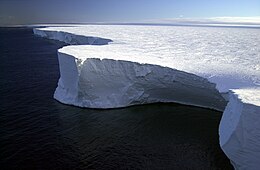Iceberg
Iceberg
انت في الصفحة 1 من صفحتين

Iceberg

An iceberg is a piece of freshwater ice more than 15 m long[1] that has broken off a glacier or an ice shelf and is floating freely in open (salt) water.Smaller chunks of floating glacially-derived ice are called "growlers" or "bergy bits"The sinking of the Titanic in 1912 led to the formation of the International Ice Patrol in 1914. Much of an iceberg is below the surface، which led to the expression "tip of the iceberg" to illustrate a small part of a larger unseen issue. Icebergs are considered a serious maritime hazard.
Icebergs vary considerably in size and shape. Icebergs that calve from glaciers in Greenland are often irregularly shaped while Antarctic ice shelves
often produce large tabular (table top) icebergs. The largest iceberg in recent history، named B-15، was measured at nearly 300 by 40 kilometres (186 by 25 mi) in 2000. The largest iceberg on record was an Antarctic tabular iceberg measuring 335 by 97 kilometres (208 by 60 mi) sighted 240 kilometres (150 mi) west of Scott Island، in the South Pacific Ocean، by the USS Glacier on November 12، 1956. This iceberg was larger than Belgium.

The word iceberg is a partial loan translation from the Dutch word ijsberg، literally meaning ice mountain،cognate to Danish isbjerg، German Eisberg، Low Saxon Iesbarg and Swedish isberg
Typically about one-tenth of the volume of an iceberg is above water، which follows from Archimedes's Principle of buoyancy; the density of pure ice is about 920 kg/m3 (57 lb/cu ft)، and that of seawater about 1،025 kg/m3 (64 lb/cu ft). The contour of the underwater portion can be difficult to judge by looking at the portion above the surface.














